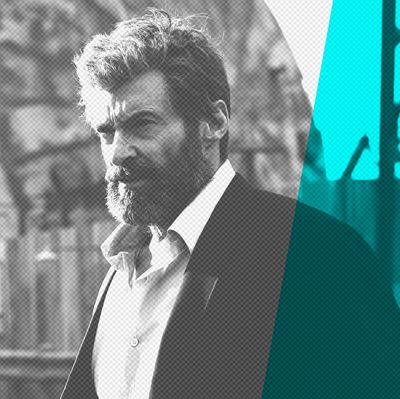
Every year, we march closer and closer to Peak Superhero. There has to come a day when the genre’s bubble of cultural dominance, which has slowly inflated for the past decade and a half, will pop. But that day seems very far away at the end of 2017, what with all the spandex-clad movies, shows, and comics currently saturating the entertainment market. In recognition of that cross-pollination, here’s a new thing we’re trying out: a combined list of the ten best superhero stories of the year, across all platforms. We tried to look for discrete narratives, ranging from an entire season of television to single issues of comics series, along with one special exception for a story that hasn’t yet been finished. We had to make difficult calls and leave off such deserving entries as Wonder Woman (the movie) and Black Bolt (the comic), which speaks to how great of a year this was for superhero stories. Don your cape and cowl and join us.

The Unbeatable Squirrel Girl, “I’ve Been Waiting for a Squirrel Like You” (Comics)
It’s rare to find an all-ages superhero book that feels like it counts. There are plenty of great kid-friendly titles in other genres, but cape comics largely abandoned the youth market a few decades back, so when a series skews young, it often feels profoundly third- or fourth-tier in terms of quality and relevance in the cultural conversation. Blissfully, this has never been the case with The Unbeatable Squirrel Girl, and the arc that appeared in issues 22 through 25 was a perfect example of its vitality. It follows the title character and her best friend as they travel to a dinosaur-laden patch of the Marvel Universe to save it from outdated technology, and it’s a goddamn delight. Writer Ryan North infuses the story with Gchat-friendly humor and real computer programming, which have become wonderfully idiosyncratic motifs of the series; and artist Erica Henderson provides visuals that are at once hilarious and emotionally evocative. This story, like all the previous ones in the series, both eats nuts and kicks butts.

Thor: Ragnarok (Movie)
It basically doesn’t matter that Thor: Ragnarok lacks emotional oomph; to watch it is to simply have too much fun to care. There are clever stabs in the direction of messages about imperial bloodthirst and proletariat revolution, but they’re decidedly back-burner concerns. The magic of Ragnarok lies in its understanding that superhero stories are, in many ways, fundamentally silly — and its commitment to making sure that silliness is handled without relying on condescension and winks. Joke after joke lands with a grace rarely seen in superpowered cinema (Deadpool looks positively wooden by comparison) thanks to the expertise of its writers and the director who often ignored what they wrote, Taika Waititi. The performers are hardly slouches, either: Chris Hemsworth has never been more charming, Mark Ruffalo is an ideal nebbishy straight man, and Cate Blanchett leaps into the upper tier of Marvel baddies without breaking a sweat. The glib Marvel Studios formula is getting a little played out, but this flick knows how to milk it for whatever it has left.

The Lego Batman Movie (Movie)
Ben Affleck’s Batman has been having a rough go of it at the multiplex. The live-action Bruce Wayne has tripped over his own pathos in Batman v Superman: Dawn of Justice and Justice League, and it’s unclear whether the next Bat-flick will even have Batfleck. But do not despair for the Caped Crusader’s big-screen prospects: He’s safely preserved in plastic. Spinning out of The Lego Movie, the star-studded Lego Batman Movie holds its own against any Dark Knight picture of the past decade. Will Arnett growls his way into your heart, and the supporting cast — Zach Galifianakis! Rosario Dawson! Michael Cera! Billy Dee Williams! Mariah freakin’ Carey! — is a surplus of riches. Despite being penned by five screenwriters, the plot is streamlined and dense with grade-A jokes and surprisingly moving meditations on loneliness and family. Director Chris McKay is a whiz at conducting a rhythm that is at once friendly to hyperactive kiddies and a balm for adults who are sick of bloated superhero epics. Batman has been punching around for nearly 80 years, but The Lego Batman Movie demonstrates why he’ll forever capture the imaginations of 10-year-olds and those of us who can never quite let go of the way we felt at 10.

Batman, “The War of Jokes and Riddles” (Comics)
Writer Tom King could have easily painted himself into a corner with his recent Batman comics arc “The War of Jokes and Riddles” for one simple reason: He had to come up with a ton of, well, jokes and riddles. Lucky for us, there is no finer scribe in superhero comic books right now, so the story is rich in the black-hole-bleak humor of supervillains the Joker and the Riddler. This tale of a gang war that traps Batman between those two nasties — illustrated with grim mastery by Mikel Janín and Clay Mann, among others — is one about balance and the illusion of noble neutrality. Batsy thinks he can stop the pair by standing in the middle, but quickly learns that he’s only reinforcing their lethal stalemate. But how can he possibly side with one or the other and preserve his soul? It’s a delicious story (literally, in the case of the issue that centers around an elaborate dinner) that, like all great Batman narratives, leaves you with more questions than answers. In the words of Kite Man, the F-list bad guy that the story elevates to the level of magnificent underdog: Hell, yeah.

Spider-Man: Homecoming (Movie)
This entire damn year, every time I’ve thought of Spider-Man: Homecoming, I’ve started to play MGMT’s “Time to Pretend” in my head. The initial reason was simply that it’s what plays during one of the film’s early trailers, but now, I think it has to do with thematic synchronicity. The song is one of the great pop documents of youthful hubris, boasting that “I’m feeling rough, I’m feeling raw, I’m in the prime of my life.” Isn’t that the essence of why we love stories of young Peter Parker? Even after he learns that great power must lead to great responsibility, he’s still prone to self-confident and self-defeating overreach, vainly thinking he can balance work and life. In Homecoming, we do indeed see Tom Holland’s Spidey in the prime of his life, filled with the unpredictable energy of late adolescence, and there’s never been a better screen depiction of him. On top of that, in the form of Michael Keaton’s Vulture (no relation to this website), it has the rare jewel of a bad guy who’s genuinely unsettling, less because he’s an evil schemer and more because he’s a disapproving grown-up. By the time Peter has to summon all of his regrets, responsibilities, and aspirations in order to re-create The Amazing Spider-Man No. 33, we’ve fully bought into his emotional journey and want him to succeed because we wish our younger selves could have. Plus, it’s all very, very funny. As MGMT put it: “We’ve got the vision, now let’s have some fun.”

Silver Surfer, “A Power Greater Than Cosmic” (Comic)
The dear, departed Silver Surfer was one of the most reliably excellent comics series on stands. Ever since Dan Slott, Mike Allred, and Laura Allred took over the title character’s adventures in 2014 and paired him up with everyday human Dawn Greenwood for improbable adventuring (“Anywhere and everywhere — hang on!” was the book’s tagline, and sheesh, who even has taglines for comics anymore?), it had been a blue chip. The sorrow of watching the run end with the 14th issue of the latest volume was mitigated only by the sheer joy of witnessing that issue’s execution. In just 21 pages, our storytellers crafted one of the most affecting comics narratives of the year, a journey across the cosmos that stretched back to before the Big Bang and spanned a legion of worlds. It was a story about love, loss, memory, hope, and families both chosen and inherited. It was filled with wondrous images that fulfilled the promise of Marvel Comics’ long tradition of otherworldly aesthetics. It was the rare superhero yarn that had a firm and satisfying conclusion. Hell, it made you get all weepy about the Silver Surfer, the most austere of all the Marvel heroes. One hates to see Silver Surfer go, but one loves to watch it leave.

Legion, Season One (TV Show)
It almost feels like Legion comes from some alternate dimension where people learned the right lessons from the comics of the mid-1980s. For the most part, imitators of Watchmen, The Dark Knight Returns, and their ilk took away the message that superhero stories need to be dark and “realistic” in order to be compelling. If only they’d instead decided that the thing to ape from those works isn’t their content, but their ambition to move the genre forward stylistically and thematically. Legion isn’t a perfect show: It could be stultifying at times, its gender politics left something to be desired, and it was a liiiiiittle too on the nose in naming one of the leads Syd Barrett. All of that said, I have never seen a superhero TV show with such ambitious aims and admirable execution of them. Creator Noah Hawley and his cast and crew sought to create a tale of meta-humans on the run that felt like nothing else on the airwaves of any genre, filled with innovatively off-kilter designs and constantly surprising performances. There were those who complained that it was too confusing, that it was unclear what was real and what wasn’t. But that’s sort of the point: Unlike every other product of comics-adapted television, Legion wanted to throw you off, not coddle you. Nevertheless, it was anchored in the struggles of those of us who live with troubled brain chemistry, as well as anyone (and this list is growing) who is a target of a bigoted government. And it gave us Aubrey Plaza starring in a Cabinet of Dr. Caligari homage, and didn’t we all need that in this difficult year?

Deathstroke, “Chicago” (Comic)
There’s a bit of dialogue in “Chicago,” a single-issue story in Deathstroke, that I had to read a few times before I could believe what I was seeing. A white reporter is talking to the black mother of a woman killed in an act of gun violence. The topic is her endorsement of super-antihero Deathstroke’s killing spree against black gang members. “Of course, you do realize, these are black men and boys being killed, presumably by a white guy,” the reporter says. “If this was a white cop, you’d burn this city down.” Her reply: “My baby was black. The gang who shot her was black. If a white cop gunned her killer down, I’d bake him a pie.” How on earth did such a nuanced, troubling, and frank discussion of race and gun violence end up in a superhero comic? Well, that’s what you get when you give creative freedom to Christopher Priest, one of the best superhero writers of his generation and a talent we’re exceedingly blessed to have on an ongoing series. Joined by the superstar art team of penciler Denys Cowan, inker Bill Sienkiewicz, and colorist Jeromy Cox, Priest offers up a jaw-dropping twist on the weary trope of cape comics tackling social issues in a “very special episode.” There are no easy answers in “Chicago” — in fact, there are no answers at all. There is only a world gone wrong that we nevertheless have an obligation to try and fix, impossible as that task may seem.

Logan (Movie)
Do we really need another bleak vision of an angry dude who channels his angst into butchering bad guys? Well, when it’s done this thoughtfully, then yes. Despite being an operatic vision of violence, Logan is far more critical of the brutality of the superhero genre than any movie I’ve ever seen. In this pitch-perfect dystopia, we see the awful consequences of humanity’s inhumanity to itself, utterly free of the fantastical protective covers of laser beams and nameless aliens. We also see a profound attack on cynicism: It’s a story about the title character learning to cast aside his narcissistic anguish and fight to protect the good against the tide of racialized exploitation and rapacious capitalism. It’s taut, it’s inventive, it’s filled with passionate performances, and it even manages to be hilarious at times. Indeed, the funny bits are far funnier than the ostensibly comedic superhero movies we so often see at the cineplex, because the humor comes not from punch-up gags and cultural references, but rather from character relationships and the quest for meaning in an increasingly grim world. On top of all that, the last shot is one of the greatest visuals to ever grace an X-Men story, and that’s no small feat. Farewell, Wolverine. You done good.

Mister Miracle (Comics)
I know, I know; I’m cheating a bit because this story isn’t complete yet. But hey, my colleagues at Vulture got away with naming Twin Peaks the best TV show of 2017 back before it was done, so I’m going to follow precedent. In fact, Twin Peaks circa July is a decent comparison point for Mister Miracle — not so much in terms of themes or structure, but in terms of general consensus that it’s the best piece of ongoing storytelling in its medium. Ask nearly any regular reader of superhero comics what book they most look forward to every month and they’ll tell you it’s this sucker. They have good reason to be excited about its tale of a super–escape artist navigating the lasting legacy of abuse and war. Penciler-colorist Mitch Gerads has demonstrated a total mastery of the micro-movements and fecund formalism of the nine-panel grid, and his facial acting sears itself into your memory. The artwork walks hand in hand with the stunning writing from Tom King, who weaves a chilling narrative of mental illness and the oxymoron of righteous violence. I’ll say no more, because it’s best to walk into this book without any knowledge of what’s to come. This year would have been the centennial of the title character’s creator, the peerless writer-artist Jack Kirby, and I can think of no better birthday present.

